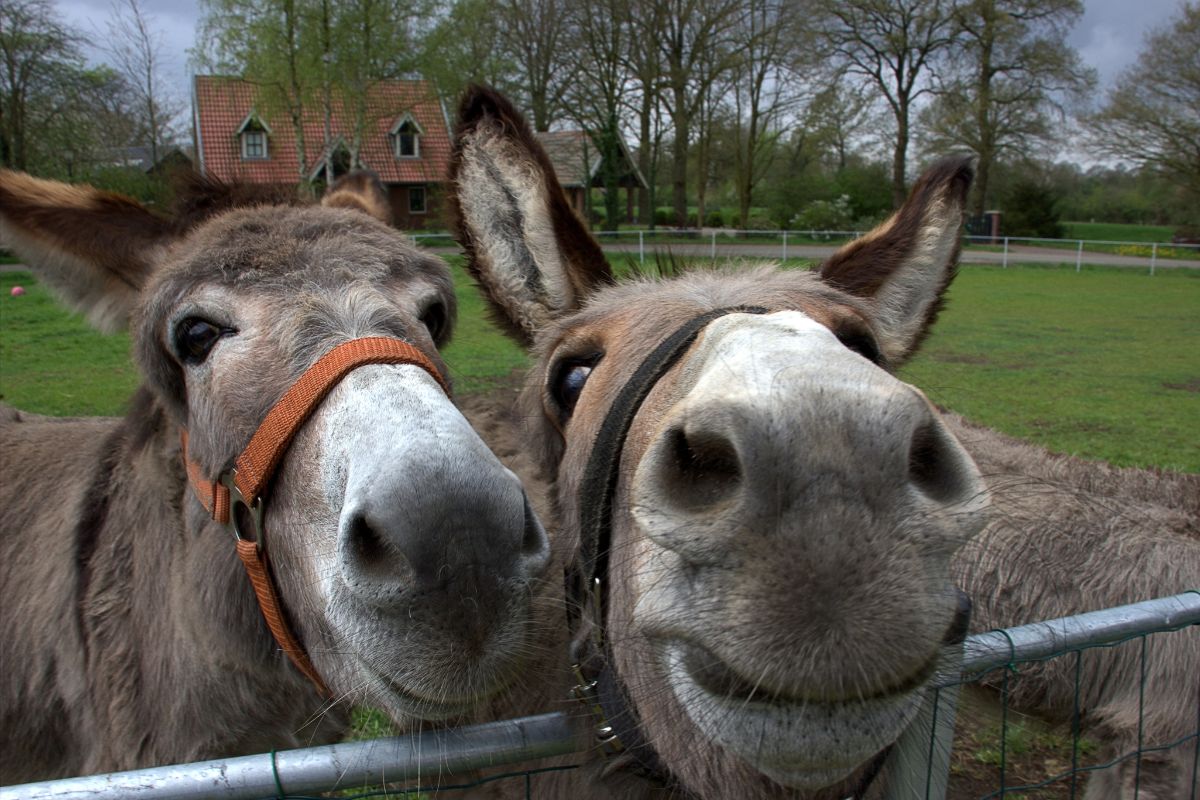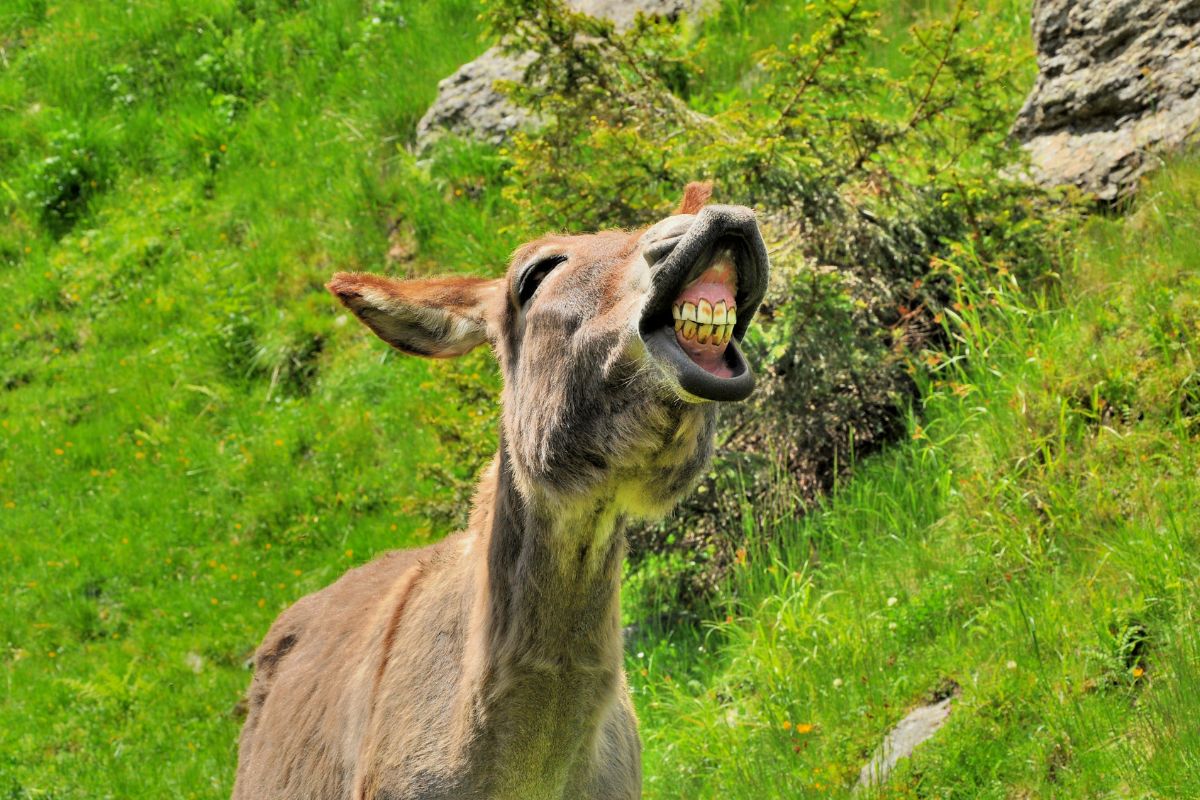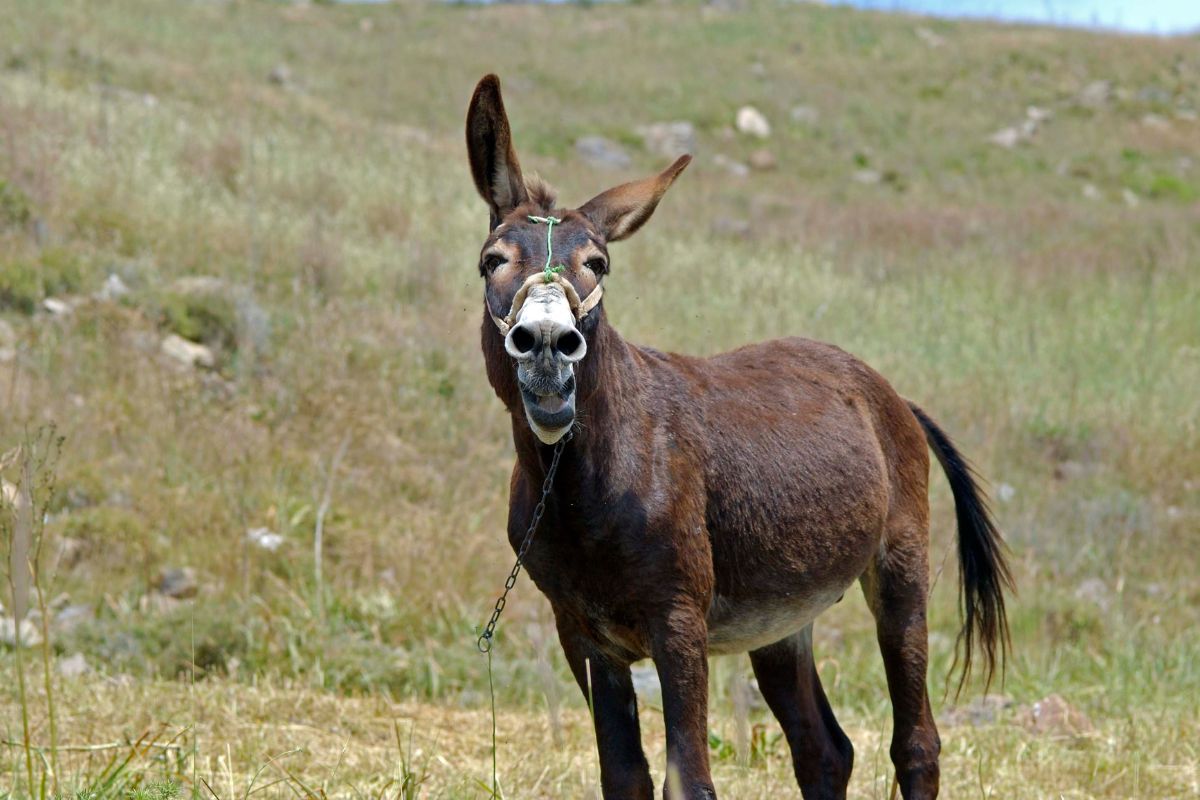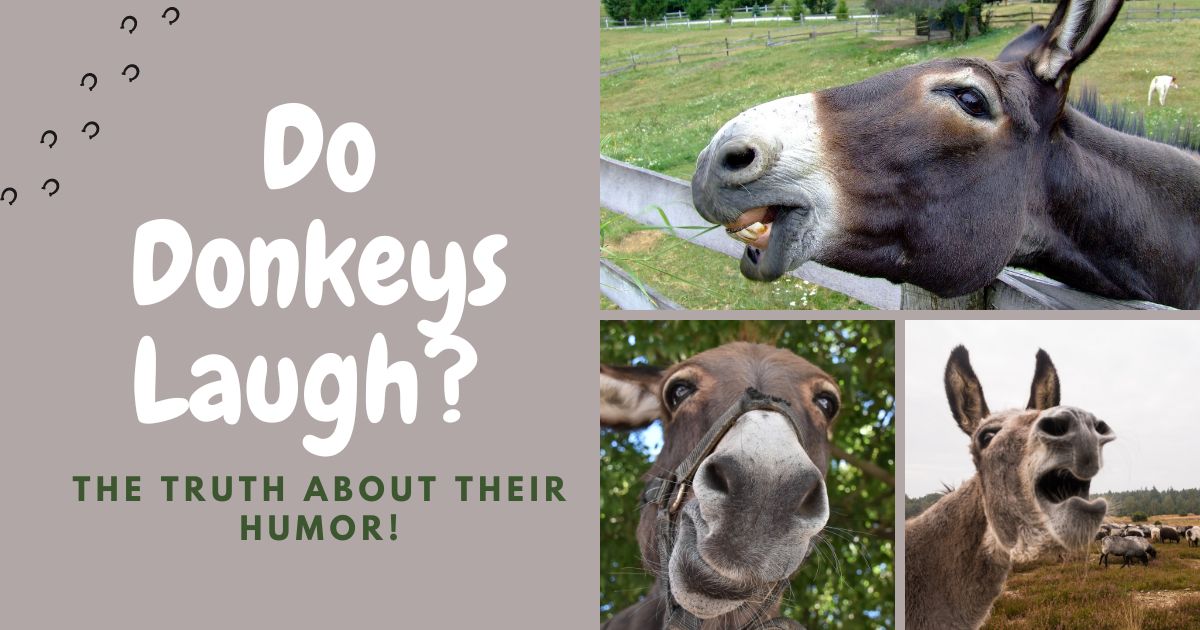Donkey Humor
Do donkeys laugh? Donkeys often respond to their surroundings by making a hee-haw sound like a giggle. People mistakenly think donkeys laugh because of their peculiar facial expressions when hee-hawing or braying.
Although they don’t laugh, donkeys’ facial gestures and sounds match what people associate with laughter.

Why Does a Donkey Laugh?
People believe donkeys laugh due to the noise they produce. They produce a booming hee-haw sound. Their hee-haw sound is the popular bray. They frequently bray when exhibiting a flehmen response. The combination of facial expressions and the noises they produce closely resembles human laughter.
Braying is how donkeys communicate with one another. This is also how a donkey expresses hunger, rage, and distress. The hee-haw sound corresponds to their inhalation and exhalation; the hee sound occurs when they inhale, and the haw sound occurs when they exhale.
Occasionally, donkeys produce a variety of bray noises. Depending on the donkey’s breathing pattern, it could be hee-haw or haw-hee. A series of short bellows always accompany the hee-haw sound. Although it does not appear that donkeys can control their noises, scientists are conducting more research on their brays.
Donkeys have a loud, occasionally brassy timbre. You can hear their hee-haw up to three kilometers (3000 meters) from their location. Additionally, donkeys only bray when confident you will respond to their requirements. They are tolerant creatures that only express distress in extreme circumstances.
Donkeys also use the hee-haw sound to express loneliness and frustration. A professional can distinguish between the different purposes of donkeys’ succession of hee haws.
The mechanisms that allow donkeys to bray are distinct from those of horses. The placement and structure of the vocal cords in a horse and a donkey account for the disparity in the sound produced by the two animals. Although they belong to distinct horse families, their vocal cord mechanics differ.
The vocal cords of a donkey have longer laryngeal saccules. Laryngeal saccules are tissue pleats. The vocal cords produce sound on both sides.
Do Donkeys Bray When Happy?
Yes, donkeys can bray when they are happy. Donkeys are vocal animals, using their brays to communicate many emotions, including happiness, excitement, and contentment. A happy bray from a donkey is typically loud and joyful, and it may include other playful behaviors, such as tossing its head or running around.
It is important to note that donkeys may also bray for other reasons, such as communicating with other donkeys, expressing discomfort or frustration, or alerting their human or animal companions to potential danger.
Therefore, paying attention to a laughing donkey’s body language and other behaviors is important to understand the context and meaning behind their brays.
Can Donkeys Laugh?
Donkeys are among the unluckiest creatures because they cannot smile or laugh. Chimpanzees, primates, gorillas, and baboons can laugh and smile.
Among these animals, baboons have the most audible laughter. However, unlike baboons, the other creatures laugh audibly but less obviously than baboons.
What Does a Donkey Laugh Sound Like?
Do donkeys actually laugh? Donkeys make a variety of vocalizations, including brays, which are their most recognizable sounds. A bray is a loud and distinctive sound often described as a cross between a honk and a hee-haw.
The laughter-like sound some people associate with donkeys is a variation of their bray. It is a shorter, more staccato version of the typical hee-haw, which some might interpret as a laugh. However, it is essential to note that donkeys do not laugh like humans do, as laughter is a uniquely human trait.
Do Donkeys Have a Sense of Humor?
It is unclear whether donkeys have a sense of humor like humans do, as humor is a complex cognitive and emotional phenomenon that requires self-awareness and an understanding of social context.
Donkeys exhibit behaviors that some people might interpret as playful or humorous, such as rolling in the dirt, nuzzling each other, and engaging in mock fights or chasing games.
Donkeys are also intelligent and curious animals capable of forming strong social bonds with humans and other animals. They can learn to respond to cues and rewards in training or play activities.
While it is difficult to say whether donkeys experience humor as humans do, it is clear that they have complex emotional lives and can exhibit a wide range of behaviors that you can interpret as playful or amusing.

Donkey Vocals and Face Expressions
Donkeys have various vocalizations, which they use to communicate with each other and humans. The most well-known donkey vocalization is the bray, a loud and distinctive sound often described as a cross between a honk and a hee-haw. Donkeys can also make other sounds, such as grunts, snorts, and squeals, to communicate.
In addition to their vocalizations, donkeys can make facial expressions to communicate their emotions. For example, when a donkey is happy, it may bray loudly, toss its head, and lift its tail.
Why do donkeys show their teeth? When a donkey is anxious or upset, it may pin its ears back, bare its teeth, and stomp its feet. Donkeys can also use facial expressions to show affection by nuzzling or licking their human or animal companions.
Generally, donkeys are intelligent and social animals capable of expressing various emotions through vocalizations and facial expressions. By paying close attention to a donkey’s body language and behavior, humans can better understand and communicate with these fascinating animals.
What is Flemen’s Response?
Flehmen’s response is an additional visual component of the donkeys’ laughter. Flehmen’s response or flehmening displays when a donkey folds its upper lip back, exposing its front teeth, and inhales through closed nostrils. A donkey can extend its neck or hold its head high during this behavior. This behavior can last for several seconds.
Flehmen’s response also enables the transfer of pheromones and odors into the vomeronasal organ, located above the palate and below the upper part of the mouth, via a duct that exits behind the donkey’s front teeth.
Other causes of donkeys’ cheerful expressions include:
Territory
Do donkeys laugh at things? Donkeys exhibit flehmen responses to designate and defend their territory. Donkeys assert their superiority over a region by defecating and braying. Additionally, donkeys make a laugh-like sound when chasing away juvenile male donkeys from females.
Mating
In addition to sensing particular foods, donkeys smile during mating periods. They display their canines to determine the reproductive status of their female counterparts. They accomplish this by imbibing pheromones.
Donkeys also display their canines when attempting to attract the attention of females in heat. Throughout the day, they alternate between smiling, barking, and resting.
Anger and Danger
When donkeys exhibit facial expressions resembling laughter, they may be angry or in imminent peril from predators. Braying aims to attract the attention of other donkeys and human caretakers.
In contrast, the response of flehmen is a reaction to their ability to comprehend their environment through smell. They bray noisily to warn other animals of the presence of predators such as lions, wolves, and foxes.
Hunger
Before eating, they curl their lips and expose their canines to smell their food. In addition, they produce a succession of bray sequences to express their hunger.
Is There an Animal That Can Laugh Like a Human?
According to scientific research, other animals can guffaw like humans. Humans laugh because they find something amusing. It’s a little different for animals. Scientists refer to animal laughter as a form of play vocalization or sounds produced by animals during play.
Due to the difficulty in determining what play interaction between animals entails, there is little information on this topic. The difficulty lies in the variety of sounds produced. Some animals’ vocalizations are low-pitched and frequently inaudible to human hearing, making it difficult to identify them.
However, scientists published a scientific paper describing animal social play. They emphasized the significance of play vocalizations in the wild for establishing peace and expressing enthusiasm, playfulness, and other emotions.
Many species of animals exhibit vocalizations resembling laughter. They include dogs, cats, pigs, foxes, domestic cows, rats, primates, certain species of birds, and other mammals.
Some animals, such as hyenas and donkeys, do not laugh because their sound does not indicate playfulness or comfort. We simply presume that hyenas and donkeys laugh because their facial expressions resemble characteristics of laughter. By vigorously exhaling, dogs mimic human laughter expressions. Also known as play gasping.
What Should I Do if a Donkey “Laughs”?
Donkeys neigh for a variety of reasons. As a donkey caretaker, it is essential to understand the cause of your donkey’s “laugh” or hee-haw.
Suppose your donkey has been continuously braying or exhibiting “laugh-like” behavior; attempt to determine if something is wrong. Observe the donkey from a distance if it appears distressed or aggressive.
Donkeys are resilient creatures that do not express pain or distress readily. However, they may continuously bray if they are in severe agony due to an injury. If your donkey appears to be experiencing distress that you cannot identify, you should seek immediate veterinary assistance.
Positively, your donkey may occasionally be braying because it desires treats and a pat from the owner. Donkeys are pleasant creatures that enjoy interacting with other animals and their owners. Spend daily quality time with your donkeys to prevent them from feeling lonely and to ensure their happiness on your farm.

Final Musings
Although donkeys do not laugh or grin, their flehmen’s response resembles a smile. As demonstrated by the phenomena, these hee-haws sound like front-tooth brays. It can occur during discomfort, such as when a predator is attacking. Additionally, donkeys use humorous facial expressions and loud noises, similar to laughter, to attract a mate.
Hopefully, there will be more research on the play vocalizations of all animal species in the future. However, you can still refer to these responses as a smile or a chuckle because these terms describe the action. Read our article and find out The Difference Between Mule vs. Donkey.
